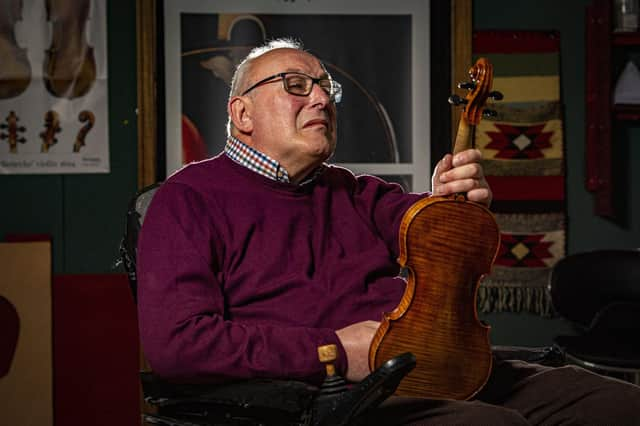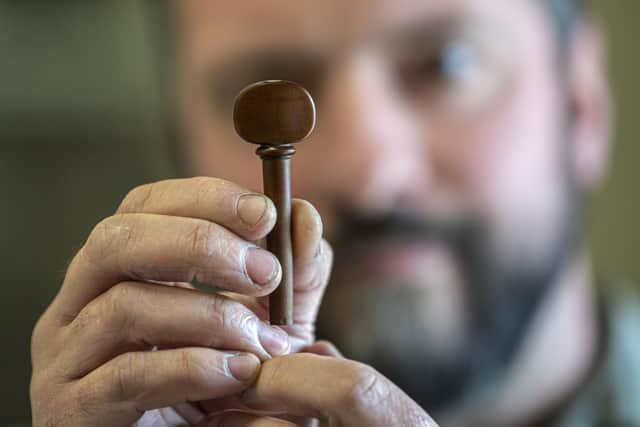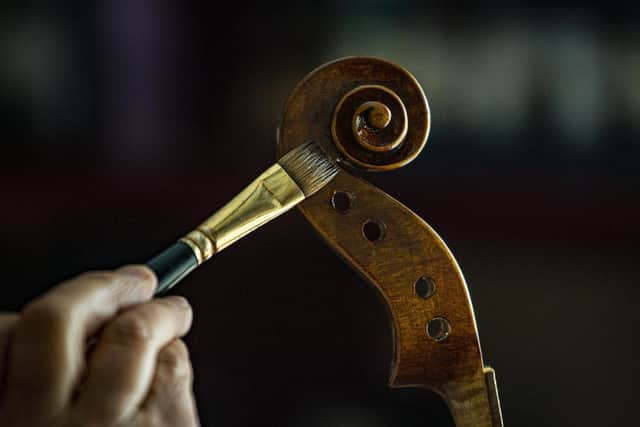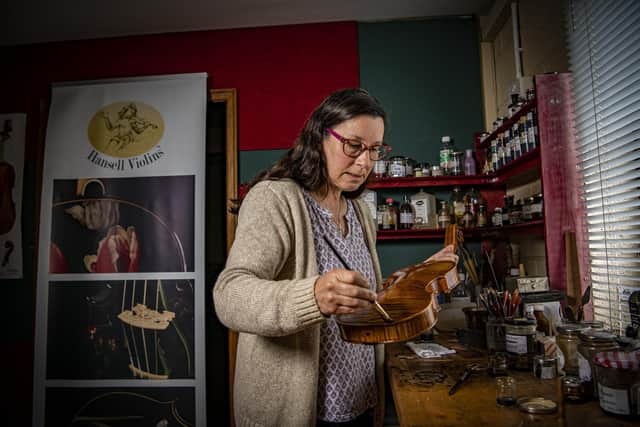Yorkshire violin makers three decades of music making despite battle MS


Before he makes an instrument, Roger Hansell listens to what a musician wants, and sometimes what they want is a violin that sounds like Amy Winehouse. Roger has been producing prized instruments since 1987, having embarked on his first violin after he was captivated by a Stradivarius at the Victoria and Albert Museum in London. Looking back now, he thinks he was drawn to violins because of the challenge, and perhaps out of cussedness.
“It might have been the feeling among friends and people that you couldn’t do it. I think that appealed, something appealed to the contrariness in me. If you say I can’t do it, I’ll do it,” he says.
Advertisement
Hide AdAdvertisement
Hide AdRoger now faces different personal challenges. On workdays he arrives at Hansell Violins in Leyburn in the back of a small van. A carer delivers him, the rear door rises, allowing Roger and his wheelchair to roll in. He has multiple sclerosis and last made a violin by himself in 2001.
Having been fuelled by a strong coffee, Roger is ready to be interviewed. You are known for making copies of famous violins, aren’t you?
“Yes, I am known for that, but I think maybe, in addition to that, I am known for working with musicians closely to try to understand what they are wanting and to try to answer that,” Roger says.
He thought it was great that someone wanted to sound like Amy Winehouse, who was “so distinctive in many ways”. During his research, he came to enjoy Winehouse, savouring the way she could move from “the thinnest, heartfelt threnody to a sort of full-bodied scream”.
Advertisement
Hide AdAdvertisement
Hide AdAnd her voice shaped his thinking for this specific project. “I had to be sure I made something that would be capable of the extremes of sound, so it had to have a very, very full expressive frequency range. The top string of a violin, the E-string, would be absolutely clear and brilliant and the bass string would be rounded and deep.”


Knowing how the player wanted to sound revealed something important about how they approached the violin.
Roger finds he now has time to think and to listen. “For me, that’s key and becoming more key because I’ve got MS. But the great thing about having MS, and that sounds off because there aren’t many great things about it, is that I get quite a lot of time to sit quietly and find myself. Through that, sound has become absolutely important to me.”
Roger makes fewer than five violins a year, preferring quality over quantity, usually working with maple and spruce. “Spruce for the top and maple for the body, although spruce is more of a constant. Spruce is a great sounding board and is also used for the tops of guitars and the soundboard of pianos.”
Advertisement
Hide AdAdvertisement
Hide AdWould he recognise one of his violins if he heard it played?


“No, I wouldn’t, but that’s how it should be. If it’s doing its job well, it sounds like all other good violins.”
Ask Roger if any aspect of making a violin is particularly difficult, he will turn the question around with a sly sparkle.
“Or is it all easy? It’s all easy unless you have standards like Stradivari – then it must be very difficult. It took him a lifetime to achieve the kind of fluency that he had. It’s both easy and difficult. It’s easy to make what people call a VSO, a violin-shaped object.”
Advertisement
Hide AdAdvertisement
Hide AdMany things can affect the sound, he says. “The wood can be thick or thin. If it’s thick, it will have a higher ring if you tap it, but there’s a whole world also of things that can be done to the violins to make them respond in different ways.


“I would say there are more ways to kill a violin, to kill the sound of a violin, than there are ways to make the sound lift up and be exceptional. It’s identifying the things that kill the sound.”
To make a violin takes three or four months, with Roger supervising.
“I don’t do any of the work, I can’t do it. I am a bit of a control freak but more controller than freak, I hope. I work very closely with the person and it’s mostly one person who is working on the instrument, and it’s good to have a very close relationship so that the nuances don’t have to be said and spelt out. They’re assumed.”
Advertisement
Hide AdAdvertisement
Hide AdRoger, who is 62, grew up on a farm at Swainby, near Northallerton, with a view of Roseberry Topping. He studied fine art at the Central School of Art in London, learning how art and craftsmanship overlap, something that has stayed with him. Making violins quickly became an obsession, and he has never had another job.
Now we look around the workshop, first meeting Georgina Keays, who has worked with Roger for 30 years.
“What’s my job, Rog?”
“Your job is key in many ways,” says Roger.
Georgina is head of fittings, and when she started Roger was still walking and he taught her to make the fittings. At the time she didn’t know one end of a chisel from the other.
“For a long time, it was just Rog and me doing fittings and Rog doing the instruments. Chin rests, pegs, Rog was doing all the design work.”
Advertisement
Hide AdAdvertisement
Hide AdNow she deals with customers and inquiries, as well as helping with fittings.
Around the other side of the bench, Matt Trout is making a seal for a copy of the Paganini Cannone violin. Sometimes Roger works from the original, but this famous violin is worth untouchable millions.
“It’s not the closest copy because we don’t have the violin and we are doing it from photographs,” says Georgina. “Roger is known for making exact copies, and if we have got the original on the
bench, he can get much closer to the original sound.”
When he isn’t fashioning a small wax seal, Matt makes the fittings, the tailpieces, chin rests and buttons, all crucial to the finished violin, using a CNC machine. This roughs out shapes which are finished by hand.
Advertisement
Hide AdAdvertisement
Hide Ad“I programmed the machine to do what it’s doing now,” says Matt. “This sort of machine, nobody else does this. You can’t just ask anybody. It’s a custom machine.”
York musician Alan George, a founder member of the Fitzwilliam String Quartet, has a viola made by Roger.
“The viola has a deep, warm, nutty, effortless sound quality,” he says. “I was thrilled to hear for myself that it almost made me sound like an Eastern European viola player when playing Russian and Czech music.”
The quartet’s relationship with Roger dates back to 1987 and came about through former second violinist Jonathan Sparey who, like Roger, lives in Wensleydale.
Advertisement
Hide AdAdvertisement
Hide Ad“He first announced himself to the rest of us with an extraordinary violin painted with tulips. Yet it sounded amazing,” says Alan.
Lucy Russell, leader of the quartet since 1996, has two Hansell violins, including a copy of a Guarneri del Gesù.
Alan commissioned a viola from Roger, inspired by the Testore viola that he had been playing since 1972.
“Roger reproduced the Testore’s dimensions, but otherwise it was his own creation. And what a masterpiece,” says Alan.
Advertisement
Hide AdAdvertisement
Hide Ad“I played on it exclusively in the quartet for many years afterwards, and still go back to it quite often. It’s particularly dear to me since it was delivered in 1995, very soon after my nine-year-old daughter Jessica succumbed to a brain tumour.”
In 2008, cellist Heather Tuach acquired a copy of a Goffriller cello, made by Roger for Moray Welsh.
“His feel for wood, how it resonates and vibrates, is second to none: assuredly there is a real touch of genius about Roger Hansell,” says Alan.